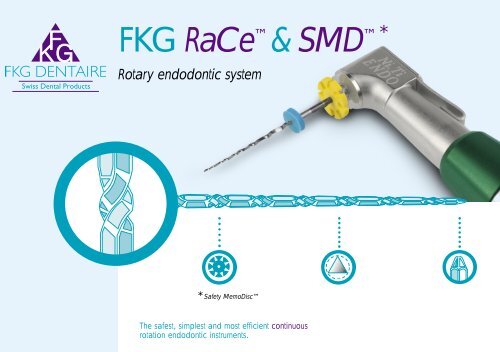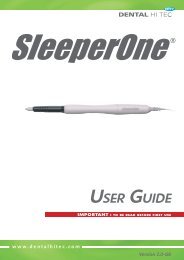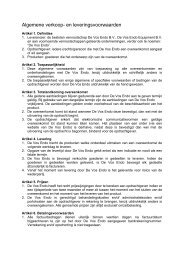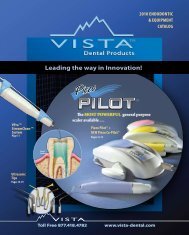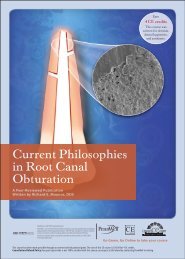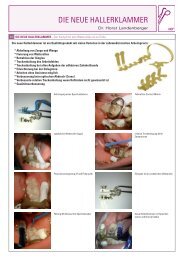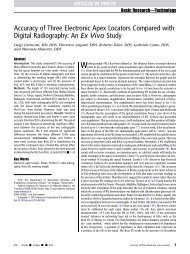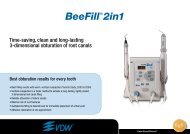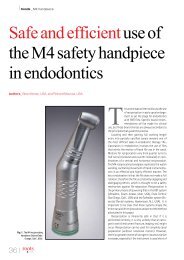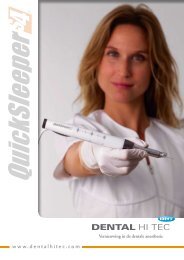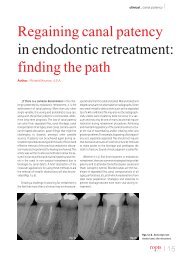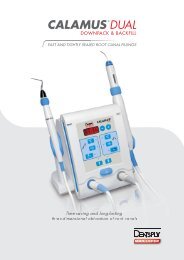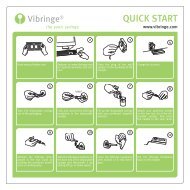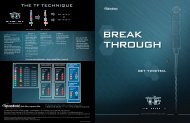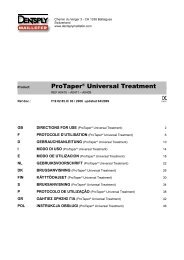FKG-Race brochure-01B-AN - Endodonzia Dr. Mauro Venturi Home
FKG-Race brochure-01B-AN - Endodonzia Dr. Mauro Venturi Home
FKG-Race brochure-01B-AN - Endodonzia Dr. Mauro Venturi Home
- No tags were found...
Create successful ePaper yourself
Turn your PDF publications into a flip-book with our unique Google optimized e-Paper software.
<strong>FKG</strong> RaCe & SMD *Rotary endodontic system*Safety MemoDiscThe safest, simplest and most efficient continuousrotation endodontic instruments.
2Rupture incontinuous rotationAccording to manufacturer'sstatistics, more than 90% ofthe cases of ruptured NiTiinstruments, could be avoidedby either:• respecting the instructions forproper use• mastering metal fatigue (provokedby the rapid successionof compressions andextensions of the instrument ina curved canal)Continuous rotationAvoid 9 ruptures out of 10From Stainless steelto NiTiWith the appearance of nickeltitaniumalloys a few yearsago, the domain of endodonticinstrument production discovereda material which is flexible,extremely elastic, resistantand bio-compatible. Workingin continuous rotation becamepossible, through which a simplicityof use and incomparabletime savings were achieved.
The Safety MemoDisc (SMD )offers perfect control over metalfatigue. With the <strong>FKG</strong> RaCe and the Safety MemoDisc , <strong>FKG</strong>offers two unprecedented solutions,innovative and high-performance,which allow one toavoid 9 out of 10 ruptures.3Have a light hand!300 - 600 rpmScrewing on/blocking in continuous rotationacbdMost conventional reaminginstruments (in stainless steel)are designed like screws, havingone or more cutting helixes.Meant to be used for filingdown (a longitudinal, back andforth movement), they all havesharp edges, which make themvery efficient for cutting. Whenused in continuous rotation, onemain inconvenience appears:the increased risk of screwingon/blocking, which inevitablyends up in the instrument fracturing.In order to avoid the screwingon phenomenon, rotary endodonticinstrument manufacturershave come up with twotypes of solutions:1. a more or less important bitingoff of the cutting angles ofthe edges (a+b)2. the introduction of a concentricindicator (radian sideface) on the cutting edges(c+d)These modifications have oftenproven themselves to be useless,even without taking intoconsideration that they bringwith them a reduction of thecutting efficiency and an increasein the working couple(which leads to the risk of rupture).
4<strong>FKG</strong> RaCe distinguishes itselfby having the lowest workingtorque on the market (attested toon trial runs), which permits oneto use the entire working length ofthe instrument and to avoid complicationsresulting from differentconic alternations.Another advantage to this lowworking torque: <strong>FKG</strong> RaCe doesnot require a limitation of thecouple proposed by certainmotors. The operational protocolis therefore extremely simplifiedand the number of instrumentsnecessary for reaming the canalis greatly reduced. From this, weobtain a certain security in usingthese instruments, comfortableworking conditions as well as aprecious saving of time.The <strong>FKG</strong> RaCe instrumentationalso gives excellent results inthe case of subsequent endodontictreatments.<strong>FKG</strong>RaCe Ease in spite of difficultyThe alternativeSafety MemoDisc <strong>FKG</strong> opens up a new waywith RACE (Reamer with AlternatingCutting Edges), a totallyinnovative system, safe and easy,developed to mitigate the limitswhich are imposed by continuousrotation.Combining a triangular sectionwith sharp edges andalternating cutting edges, the<strong>FKG</strong> RaCe instruments combineall of the determining advantagesof endodontic practice:• The alternating cutting edgeseliminate the screwing on/blocking and only leads to aweak working torque• The sharp edges guaranteeoptimum cutting efficiency;• The combination of a triangularsection and alternatingcutting edges ensures efficientevacuation of chipsand cutting debris• The system is available in 2%taper (ISO standard) or 4, 6,8 or 10%.• The <strong>FKG</strong> safety tip ensuressure guidance/centering inthe canal• The reduction of the numberof instruments necessary forthe preparation of the canalprovides comfort and savestime
Sharp Cutting Edges5Magnification:Alternating Cutting Edges<strong>FKG</strong> Safety Tip10 x40 x60 x• The maintenance of a maximumdentine thickness increasesthe chances of longterm success• The trajectory of the originalcanal is respected thanksto the flexibility of NiTi tothe 2% taper, to the designof the <strong>FKG</strong> RaCe instrumentsas well as to the safetytip guide• Most instrument ruptures areavoided thanks to the SafetyMemoDisc (SMD )• The innovative design guaranteesbeing able to workgently and maintains tactilesense<strong>FKG</strong> RaCe and <strong>FKG</strong> SMD are protected by internationalpatents.From now on, the practitioneris the master of his instruments…and not the opposite!
SafetyMemoDisc 6Shape… and use memory8 removable petalsSolutions for NiTi fatigueIn order to prevent metalfatigue, the most reliablemethod consists of only usingeach instrument once. Thismeasure is not well adapted,since the fatigue suffered is different,depending upon thecurve of the canal... Withouttaking into consideration theparameters which are inherentto the instrument itself: size,taper, working torque and rotationspeed.With the SMD (Safety MemoDisc), <strong>FKG</strong> proposes a pragmaticsolution, reliable, efficientand extremely simple, inorder to prevent ruptures due tometal fatigue.Taking into account all of thefactors which intervene inendodontics, <strong>FKG</strong> has establisheda table according to thevalues obtained in the laboratoryfollowing fatigue tests.Starting from a maximum of8 uses of an instrument n° 025(conicity 2%) in a simple canal(straight or very slightly curved),this table indicates the numberof security points to deduct ateach treatment in function withdiverse parameters which influencemetal fatigue (size andtaper of the instrument, complexityof the canal). The numberwhich is obtained correspondsto the number of petalsto pull off of the SMD which,fixed under the sleeve, accompaniesthe instrument until it isdiscarded.
Mastering NiTi fatiguePutting into practice the SMD system71. Preliminaries Based on X-rays, determine the working length (WL).2. Complexity of the canal By superimposing the SMD gauge and the X-ray, look for thesmallest radius in the canal. Based upon the obtained value, thecanal will be classified in one of the three following categories:Radius greater than 25 mmRadius between 11 mm and 25 mmRadius between 8 mm and 11 mm= Simple canal= Medium canal= Difficult canal3. SMD flange Depending upon the chosen method of treatment and the degreeof difficulty of the canal (simple, medium or difficult), the SMD decrementation table will indicate the number of petals requiredfor carrying out the treatment.1st case: the SMD flange has a sufficient number of petalsand the treatment may be carried out2nd case: the number or remaining petals is insufficient. The concernedinstrument must be set aside for a simpler treatment,or discarded once all of the petals have beenused. Either a new instrument or one with a sufficientnumber or petals must be chosen to treat the canal.ONE USE = CONTINUOUS ROTATION OF THE INSTRUMENT IN A C<strong>AN</strong>AL CURVE DURING A MAXIMUM OF 10 SECONDS AT 600 RPM.
8What you mustknow• The flexibility of a NiTi instrumentdecreases in proportionto the increase of its conicity(an instrument n° 025 with anISO conicity of 2% is more flexiblethan the same instrumentwith 4% conicity).• The cutting effort (and thereforethe working torque) increasesin proportion to the increasein conicity.• The NiTi alloy is very well toleratedby the human body.The nickel and titanium atomsare very solidly joined togetherby covalent links whichimpede the nickel from passinginto the organism. In comparison,stainless steel has agreater quantity of free nickelatoms than the NiTi alloys.• The smaller the courvature rayonof the canal, the greater theincrease in metal fatigue.• The instrument's rotation speeddoes not have any influenceon the metal fatigue, but doesinfluence the rupture limit (thisis reached 2 x faster at a rotationspeed of 1000 rpm thanat 500 rpm).What method to use?"Crown-down"? … "Step-back"?… or another?Most continuous rotation endodonticsystems currently availableon the market are onlyadapted to the "crown-down"technique (this is in order toreduce the risk of screwingon/blocking/rupture).On the contrary, the intrinsicqualities of the <strong>FKG</strong> RaCe instruments (previously describedin this <strong>brochure</strong>) leave the practitionerentirely free to choosethe technique to use for eachtreatment, in function with themorphology of each canal andthe desired working comfort.With this in mind, <strong>FKG</strong> has puta complete set of RaCe instrumentsat the practitioner’s disposal(generally 3 to 5 instrumentssuffice for the treatmentof a canal).(Under study)
Golden rule! never force the way!<strong>FKG</strong> RaCe & SMD ... the 7 keys to success91. Working speeds300 to 600 rpm2. Apical pressureExtremely gentle3. NoiseOverload warning4. MovementBrief and quick back and forthmovements5. ProgressionNever force the way!6. Working time5 to 10 seconds per instrument7. Metal fatigue<strong>FKG</strong> SMD methodUse a motor/contra-angle ensemble with the possibility to adjust the working speed. Otherwisehave your apparatus calibrated. Modern motors offer more and more often the possibility to alsoadjust the working torque. This is an added security against certain kinds of manipulation errors.However, since the <strong>FKG</strong> RaCe instruments do not have the screwing on problem, a conventionalapparatus is perfectly adequate.In order to give a better idea of the recommended pressure, take into your hand an <strong>FKG</strong> instrument,for example RaCe.02 n° 025 (red ring), put the point into contact with a smooth surface, and forman angle of approximately 45° between the contact point and the instrument, then press just until theinstrument begins to bend. The force used for this operation corresponds to the ideal apical pressure.A clacking of the instrument warns the practitioner that he or she is using too much apical pressure.Let the instrument work at its own speed.Avoid all prolonged stationary rotation in a curved canal. Sooner or later, the phenomenon of metalfatigue will provoke the rupture of an instrument.Avoid all forced passages. The safety tip ensures perfect guiding and centering of the instrument inthe canal. If the instrument no longer advances, do not insist. Pull it out of the canal, recapitulatemanually with the help of an ERGOFLEX H NiTi n°10, then pick up the mechanical work againwith the last <strong>FKG</strong> RaCe instrument used. The instruments <strong>FKG</strong> RaCe n° 015 and 020 can bevery useful in narrow and complex canals.<strong>FKG</strong> RaCe instruments are characterized by their optimum cutting efficiency. This quality essentiallyallows one to shorten the working time and to therefore reduce metal fatigue.Thanks to the SMD decrementation discs, <strong>FKG</strong> is the sole company to offer a method of controlling metalfatigue that is at the same time simple and efficient. After having determined the level of complexity ofthe canal to be treated, the SMD allows one to simultaneously record the "life" of the instrument as well asto save this information (even when the instrument is mixed up with other tools) until it is finally discarded.
10Apprenticeship<strong>FKG</strong> recommends that practitionerspractice on blocks of resinwhich simulate a root of averagecomplexity, and "in vitro" on teethwhich have been extracted andx-rayed. By sacrificing a fewinstruments, the practitioner willcome to know the rupture limitsas well as certain movements tobe avoided. These experienceswill be very beneficial for futurework "in vivo".RaCe & SMD Security in practicePreparationReamingAfter opening the pulpalchamber and localizing all ofthe canals (for example, withthe help of <strong>FKG</strong> F-SEARCHinstruments), the reaming of thecanal may begin.After determining the workinglength and estimating the morphologyof the canal, thestraight coronal part of thecanal (first third/till first half,depending upon the case) willbe splayed as much as possiblein the direction of theapex, with the help of the<strong>FKG</strong> PRE-RaCe .The working length which hasbeen previously determinedwill be transferred to the first<strong>FKG</strong> RaCe , which will be conductedas quickly as possibleto the desired position by briefand very light pressure in aback and forth movement. Inevery case, the ideal rotationspeed is situated between300 and 600 rpm.The work time for each instrumentis not to exceed 5 to10 seconds. Never leave aninstrument in stationary rotationin a curved canal but always
11Have a light hand!Calcified or verynarrow canals300 - 600 rpmFillingFor these very difficult cases,<strong>FKG</strong> recommends two RaCe instruments, the n o 015 and 020in taper 2%. Thanks to squarecross section, they offer increasedresistance and allow one tosuccessfully treat most difficultcanals.give it a back and forthmovement.In the case where progress isdifficult, the practitioner mustnot try to force the passage. Amanual recapitulation with an<strong>FKG</strong> ERGOFLEX (H type, NiTi)will allow one to arrive atthe end of the obstacle. Thesequence may then pick up atthe place where it was interrupted.The sequence will becontinued until the desiredream is obtained. In most cases,complete execution of thecanal reaming will require nomore than 2 to 5 instruments.Use of the SMD will ensureoptimal security throughout thesequence.The preparation of the canalobtained with the continuousrotation (step back or crowndown)suits all standard typesof filling. Be sure to use the"gutta-percha" cones with thesame number as the final apicalpreparation.
12Options:Standard handleShort handleInstr. length15 mm = GM12 mm = CM21 or 25 mm(Under study)Instr. length/Available sequencesCross- working Step-back Step-back Crown-downReferences No ISO Tapers section part (mm) Metal .06/.02 .06/.04 .10–.04/.02Pre-RaCe 01.710.19.040 GM 40 0.10 ▲ 19/9 NiTi 1 st01.790.19.040 GM 40 0.10 ▲ 19/9 AC01.708.19.035 GM 35 0.08 ▲ 19/9 NiTi 2 nd01.788.19.035 GM 35 0.08 ▲ 19/9 AC01.706.19.030 GM 30 0.06 ▲ 19/10 NiTi 1 st 1 st 3 rd01.706.19.040 GM 40 0.06 ▲ 19/10 NiTi 2 ndRaCe 01.706.25.020.GM 20 0.06 ▲ 19/10 NiTi01.706.25.025.GM 25 0.06 ▲ 19/10 NiTi01.706.25.030.GM 30 0.06 ▲ 19/10 NiTi01.704.25.025 GM 25 0.04 ▲ 25/16 NiTi 3 rd 4 th01.704.25.030 GM 30 0.04 ▲ 25/16 NiTi 4 th01.704.25.035 GM 35 0.04 ▲ 25/16 NiTi 5 th01.702.25.015 GM 15 0.02 ■ 25/16 NiTi01.702.25.020 GM 20 0.02 ■ 25/16 NiTi01.702.25.025 GM 25 0.02 ▲ 25/16 NiTi 2 nd 5 th01.702.25.030 GM 30 0.02 ▲ 25/16 NiTi 3 rd01.702.25.035 GM 35 0.02 ▲ 25/16 NiTi 4 th01.702.25.040 GM 40 0.02 ▲ 25/16 NiTi 5 th01.702.25.050 GM 50 0.02 ▲ 25/16 NiTi01.702.25.060 GM 60 0.02 ▲ 25/16 NiTi Total 5 instr. Total 5 instr. Total 5 instr.SequencesRaCe.06/.02 01.720.25.S25 GM 30/25/30/35/40 .06/.02/.02/.02/.02 NiTiRaCe.06/.04 01.721.25.S25 GM 30/40/25/30/35 .06/.06/.04/.04/.04 NiTiRaCe.10-.04/.02 01.722.25.S40 GM 40/35/30/25/25 .10/.08/.06/.04/.02 NiTiRaCe.10-.04/.02 01.723.25.S40 GM 40/35/30/25/25 .10/.08/.06/.04/.02 AC/NiTi
Accessories,training supports and kits13AccessoriesCatheterization: ERGOFLEX H NiTi n° 010 or K NiTi n° 015Application of the filling paste: automatic disengaging paste packer SENSIPASTFilling: Gutta Percha points normalized for <strong>FKG</strong> RaCe .02 (the <strong>FKG</strong> RaCe .04 and .06 requirean adapted taper)*Research of the canal orifice(s): F-SEARCHWork sequence support: RaCe & SMD support*Decrementation flange: Safety MemoDisc (color code of the tapers)Delimitation of the working length: endodontic stops (color code indicating the length of the instrument)Distribution/adaptation of the endo-stops to the working length: STOP DISPENSER/STOP CARTRIDGEDetermination of the canal's curve rayon: SMD rayon gaugesEstimation of the instrument's fatigue level: SMD decrement tableChecking/calibrating the rotation speed of the counter-angle:** under study
14A pioneerof mechanized canal reaming<strong>FKG</strong> figures today among the pioneers of mechanizedcanal treatment thanks to many years of experience in thisdomain. <strong>FKG</strong> collaborated in the fine tuning of stainless steelinstruments used in most oscillating movement systems such asCanal Finder or Canal Leader 2000.The practical knowledge and the technological advances accumulatedby <strong>FKG</strong> over the years have been determining factors forapproaching the new era in endodontics: continuous rotationtreatment.
PRE-RaCe and RaCe instruments15IdentificationL2 (working part)Synoptical tableL1 (total length)Taper*CC ISO *CC Taper *CC L1/L2No 15No 20/50No 25No 30/60No 35No 40PRE-RaCe = 10%,RaCe = 2 %PRE-RaCe = 8%,RaCe = 4 %PRE-RaCe = 6%,RaCe = 6 %19/10 mm21/16 mm25/16 mm28/16 mm31/16 mmPRE-RaCe& SMDRaCe &SMDAvailable sequencesReferences01.XXX.XX.XXX.XXHandle (standard or short)*ISO dimensionsLength (21 mm or 25 mm)Article + taper + metalReaming instruments* standard: 15 mm (ref. GM)short: 12 mm (ref. CM)
RaCe = Reamer with AlternatedCutting EdgesSMD = Safety Memo Disc(sterilizable SMD decrementflange)<strong>FKG</strong> safety tipEndodontic stops<strong>FKG</strong> finish(NiTi surface condition)<strong>FKG</strong> RaCe & SMD Exclusively <strong>FKG</strong>Resolves all of the screwing on/blocking problemsOne of the lowest working couplesCutting efficiency maintained at 100%Maximum reduction of the number of instrumentsExcellent debris evacuationRespects the morphology of the canal thanks to the "step-back" methodMaximum flexibility (weak taper of instruments: 2%)Applicability of the "crown-down" methodTreatment of calcified or narrow canals (ISO dimensions n° 015 and 020 with 2% taper)Mastering of NiTi fatigue by using a radius gauge, as well as a decrementation table andflangeOptimal use of instruments by checking the parameters which influence NiTi fatiguePresence of the SMD flange on the instrument right up until its final destruction.Preservation of the instrument’s past history even when mixed up with other tools.Indication of the taper of the instrument via color codes.Excellent centering-guiding in the canalDecreased risk of perforation and deviationPresented in factory seriesColor codes of the instrument’s length and its active partReduction of starting points of ruptures due to grindingElimination of manufacturing residue (burrs)Improved instrument appearance16
<strong>FKG</strong>Rooted… in quality17A story of teeth…and gearsEstablished in the heart of theJura mountains, a region with along tradition of precision andmicro-technical expertise, <strong>FKG</strong>was founded in 1931 by theassociation of a dental technicianand a precision mechanicwho had been working in thewatch making industry.From its early beginnings, theenterprise chose to develop intwo realms which seem to havenothing in common – otherthan perhaps a certain taste forprecision- the watch makingsector (watch face applications)and dentistry (instrumentsand other products).With time, <strong>FKG</strong> specialized ininstruments for preparing thecanal, as well as in variousproducts such as matrices andendodontic implants. Severalinteresting inventions camealong to crown all these yearsof research and development,giving <strong>FKG</strong> its current internationalstatus.
… safer!… easier!… more efficient!99.720.00.<strong>01B</strong> <strong>AN</strong>Printed in Switzerland<strong>FKG</strong> Dentaire7, rue du Crêt ▲ CH-2302 La Chaux-de-FondsPhone: ++41 (0)32 968 85 25Fax: ++41 (0)32 968 12 52E-mail: info@fkg.ch ▲ Internet: www.fkg.chSuisse - Switzerland<strong>FKG</strong> RaCe & SMD Rotary endodontic system


